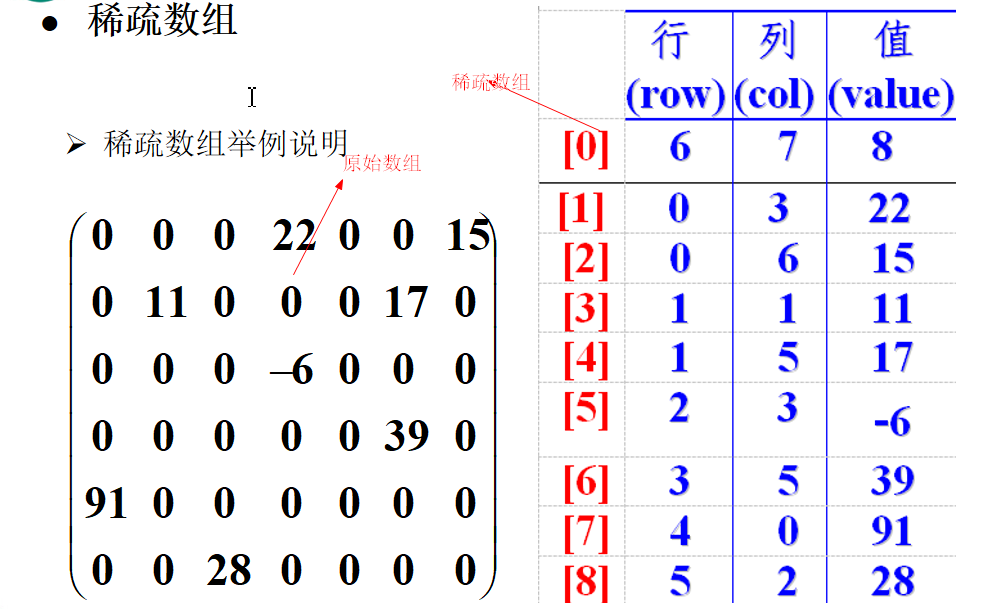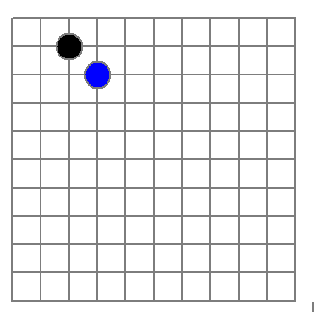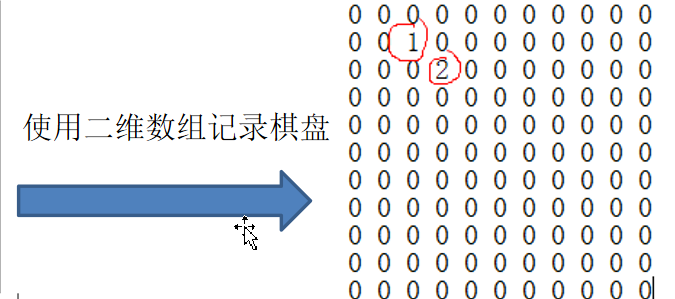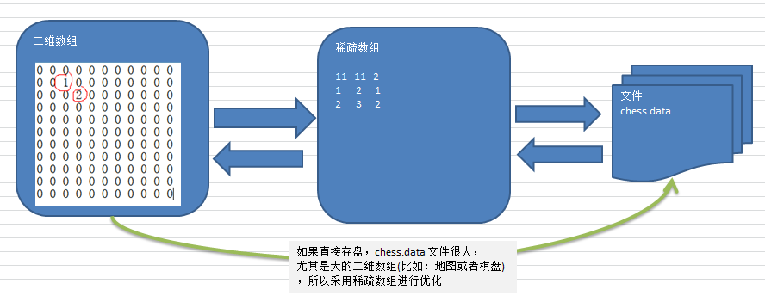Sparse array
Basic introduction
When most of the elements in an array are 0, or an array with the same value, a sparse array can be used to hold the array.
The processing method of sparse array is as follows:
1. How many rows and columns are there in the record array? How many different values are there
2. Record the columns and values of elements with different values in a small array, so as to reduce the size of the program
Sparse array example:

The first row of the right array is 6 = how many rows are there in the left array, 7 = how many columns are there in the left array, 8 = how many non-zero values are there in the left array, and then the next eight rows hold the coordinates and values of the data.
practical application
In the program of Gobang, it has the function of saving, exiting and continuing.


Analysis problem: because many values of the two-dimensional array are 0 by default, a lot of meaningless data is recorded, so we can use sparse array to store at this time;
Thought analysis:
1. Use sparse array to keep the previous two-dimensional array (chessboard, map, etc.)
2. Save the sparse array to disk, and restore the original two-dimensional array number
3. Overall thinking analysis

4. Code implementation
Code package com.sparseArray; public class SparseArray { public static void main(String[] args) { // Create an original 2D array 11 * 11 // 0: It means there is no chess piece, 1 means black, 2 means blue int chessArr1[][] = new int[11][11]; chessArr1[1][2] = 1; chessArr1[2][3] = 2; chessArr1[4][5] = 2; // Output original 2D array System.out.println("Original 2D array~~"); for (int[] row : chessArr1) { for (int data : row) { System.out.printf("%d\t", data); } System.out.println(); } // Thinking of converting 2D array to sparse array // 1. First traverse the two-dimensional array to get the number of non-zero data int sum = 0; for (int i = 0; i < 11; i++) { for (int j = 0; j < 11; j++) { if (chessArr1[i][j] != 0) { sum++; } } } // 2. Create the corresponding sparse array int sparseArr[][] = new int[sum + 1][3]; // Assign values to sparse arrays sparseArr[0][0] = 11; sparseArr[0][1] = 11; sparseArr[0][2] = sum; // Traverse the two-dimensional array and store the non-zero value in the sparseArr in int count = 0; //count Used to record the number of non-zero data for (int i = 0; i < 11; i++) { for (int j = 0; j < 11; j++) { if (chessArr1[i][j] != 0) { count++; sparseArr[count][0] = i; sparseArr[count][1] = j; sparseArr[count][2] = chessArr1[i][j]; } } } // Output sparse array form System.out.println(); System.out.println("Get sparse array as~~~~"); for (int i = 0; i < sparseArr.length; i++) { System.out.printf("%d\t%d\t%d\t\n", sparseArr[i][0], sparseArr[i][1], sparseArr[i][2]); } System.out.println(); //Sparse array --> Restore to original 2D array /* * 1. First read the first row of the sparse array, and create the original two-dimensional array according to the data in the first row, such as chessar2 = int [11] [11] above 2. Read the data of the last few rows of sparse array and assign it to the original two-dimensional array */ //1. First read the first row of the sparse array, and create the original two-dimensional array according to the data in the first row int chessArr2[][] = new int[sparseArr[0][0]][sparseArr[0][1]]; //2. Reading the data of the last few rows of sparse array(Start with the second line),And assign it to the original two-dimensional array for(int i = 1; i < sparseArr.length; i++) { chessArr2[sparseArr[i][0]][sparseArr[i][1]] = sparseArr[i][2]; } // Output recovered 2D array System.out.println(); System.out.println("Recovered 2D array"); for (int[] row : chessArr2) { for (int data : row) { System.out.printf("%d\t", data); } System.out.println(); } } }
package com.sparseArray; public class SparseArray { public static void main(String[] args) { // Create an original 2D array 11 * 11 // 0: It means there is no chess piece, 1 means black, 2 means blue int chessArr1[][] = new int[11][11]; chessArr1[1][2] = 1; chessArr1[2][3] = 2; chessArr1[4][5] = 2; // Output original 2D array System.out.println("Original 2D array~~"); for (int[] row : chessArr1) { for (int data : row) { System.out.printf("%d\t", data); } System.out.println(); } // Thinking of converting 2D array to sparse array // 1. First traverse the two-dimensional array to get the number of non-zero data int sum = 0; for (int i = 0; i < 11; i++) { for (int j = 0; j < 11; j++) { if (chessArr1[i][j] != 0) { sum++; } } } // 2. Create the corresponding sparse array int sparseArr[][] = new int[sum + 1][3]; // Assign values to sparse arrays sparseArr[0][0] = 11; sparseArr[0][1] = 11; sparseArr[0][2] = sum; // Traverse the two-dimensional array and store the non-zero value in the sparseArr in int count = 0; //count Used to record the number of non-zero data for (int i = 0; i < 11; i++) { for (int j = 0; j < 11; j++) { if (chessArr1[i][j] != 0) { count++; sparseArr[count][0] = i; sparseArr[count][1] = j; sparseArr[count][2] = chessArr1[i][j]; } } } // Output sparse array form System.out.println(); System.out.println("Get sparse array as~~~~"); for (int i = 0; i < sparseArr.length; i++) { System.out.printf("%d\t%d\t%d\t\n", sparseArr[i][0], sparseArr[i][1], sparseArr[i][2]); } System.out.println(); //Sparse array --> Restore to original 2D array /* * 1. First read the first row of the sparse array, and create the original two-dimensional array according to the data in the first row, such as chessar2 = int [11] [11] above 2. Read the data of the last few rows of sparse array and assign it to the original two-dimensional array */ //1. First read the first row of the sparse array, and create the original two-dimensional array according to the data in the first row int chessArr2[][] = new int[sparseArr[0][0]][sparseArr[0][1]]; //2. Reading the data of the last few rows of sparse array(Start with the second line),And assign it to the original two-dimensional array for(int i = 1; i < sparseArr.length; i++) { chessArr2[sparseArr[i][0]][sparseArr[i][1]] = sparseArr[i][2]; } // Output recovered 2D array System.out.println(); System.out.println("Recovered 2D array"); for (int[] row : chessArr2) { for (int data : row) { System.out.printf("%d\t", data); } System.out.println(); } } }
